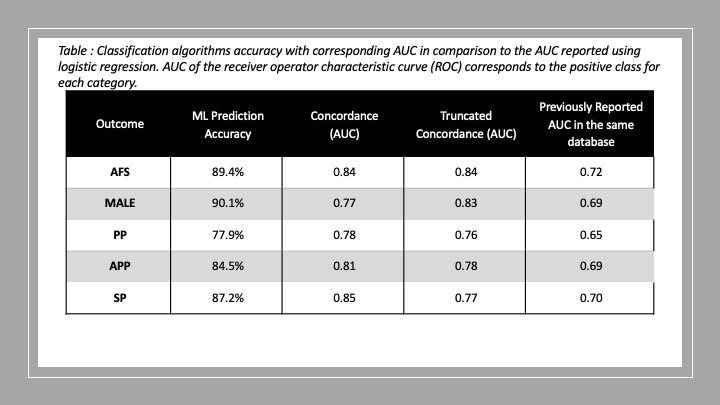A Machine Learning Classification Model To Predict Risk Of Adverse Outcomes In Patients Undergoing Peripheral Vascular Intervention (pvi)
Mohammad H. Eslami, MD, MPH1, Timothy K. Chung, PhD2.
1University of Pittsburgh Medical School, Pittsburgh, PA, USA, 2Department of Bioengineering, University of Pittsburgh, Pittsburgh, PA, USA.
OBJECTIVE: Peripheral vascular disease affects about 6.5 million people in the United States. Adverse outcomes after PVI can lead to further debilitation, therefore, identifying high-risk patients is of paramount importance. The purpose of this analysis is create a risk predictive model using Machine Learning (ML) classification algorithms and to compare the prediction ability of this model against previously reported models created. METHODS: The Vascular Quality Initiative (VQI) database for PVI (2001-2020) was used in this analysis. A total of 186,088 patients with 392 clinical indices at the time of procedure were included to train models predicting primary outcomes of amputation-free survival (AFS), major adverse limb events (MALE), loss of primary patency (PP), assisted primary patency (APP), secondary patency (SP) all at one year after the procedure. Dimensionality reduction was performed to reduce the number of clinical variables to arrive at a parsimonious model, and the classification models were retrained on the truncated dataset. Concordance of predictive parsimonious models using the entire clinical variables and a truncated list of variables (based on feature importance) with observed events were evaluated with receiver operating characteristic curves and the area under the curve (AUC). RESULTS: Of the initial 392 clinical variables included in this analysis, the final model included 32 clinical variable with good to acceptable predictive ability for the outcomes studied (Table). Table below also summarizes the predictive ability of the final models using ML methodology and compares the ROC to the previously reported ROC using logistic regression methodology. CONCLUSIONS: Machine Learning Classification yields more accurate predictive models and has better discriminability in classifying adverse patient outcomes with higher sensitivity when compared against traditional regression methods that predict patient outcomes. Future work will incorporate an additional layer of statistical analyses for the classifier model to identify risk to patients.

Back to 2022 ePosters
